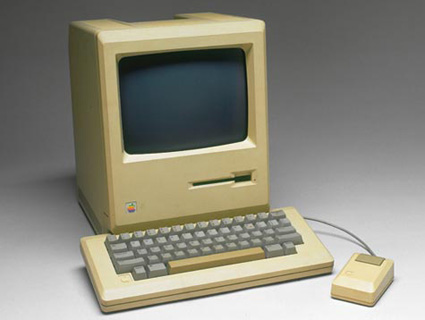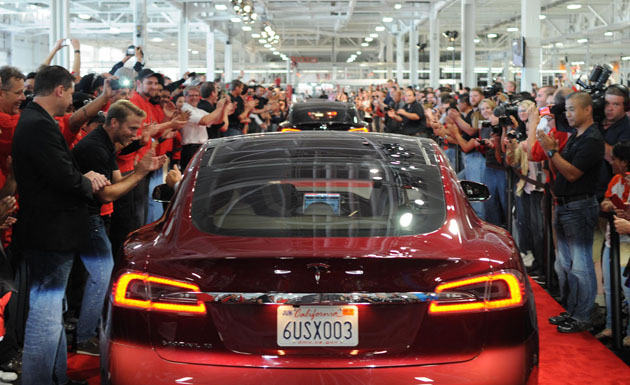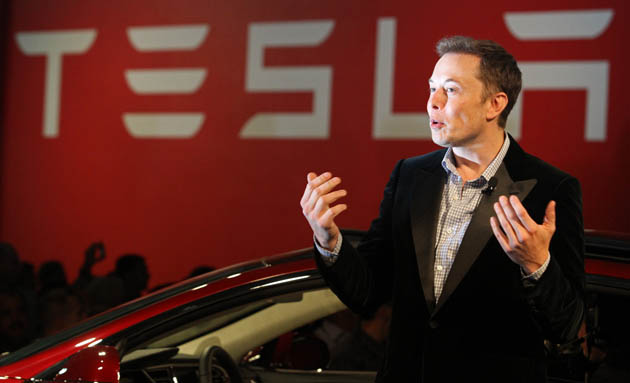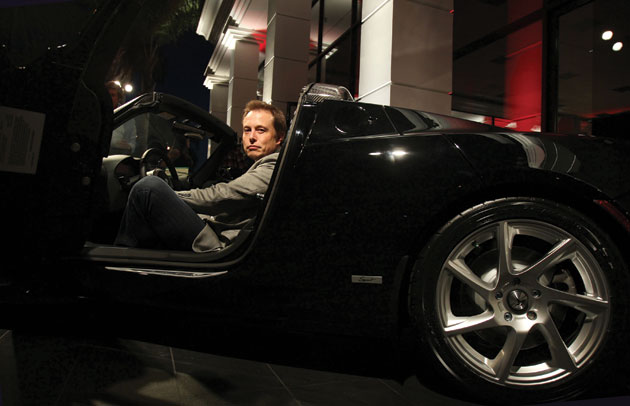
Musk shows off the Roadster at a trade show.J. Emilio Flores/New York Times/Redux
It’s rush hour in Silicon Valley, and the techies on Highway 101 are shooting me laser-beam stares of envy. Beneath the floorboard of my Tesla Model S, a liquid-cooled pack of 7,000 laptop batteries propels me down the carpool lane at a hushed 65 miles per hour. Then traffic grinds to a halt, and I’m stuck trying to merge onto an exit ramp as Benzes and BMWs whip past. It’s the excuse I’m waiting for: I punch the throttle, and the Model S rockets back up to speed so fast that I worry about flying off the road—a silly fear, it turns out, because the car corners like a barn swallow. “And there you go,” says Tina, my beaming Tesla sales rep. “Takeoff!”
Every bit as practical as a Volvo (rear-facing trundle seat!) and sexier than an Aston Martin, the Model S isn’t just the world’s greatest electric car—it’s arguably the world’s greatest car, period. The curmudgeons at Consumer Reports call the seven-seater the best vehicle they’ve ever tested, and that’s after docking it considerable points for only—only!—being able to travel 265 miles on a charge. The first mass-market electric car designed from scratch, it sports huge trunks in the rear and under the hood, an incredibly low center of gravity, and the ability to hit 60 mph in 4.2 seconds. Plus you can recharge it for the price of a burrito. Named car of the year by Motor Trend, the Model S has recharged Tesla as well. In May, the company announced that it had repaid, nine years early, a $465 million loan it had received from the Department of Energy.
Tesla posted its first quarterly profit the same month, and by mid-July the share price of the decade-old Palo Alto-based carmaker had more than doubled. The buzz in the Valley is that Tesla has in the Model S something with the disruptive potential of the iPhone—and in its CEO, Elon Musk, the next Steve Jobs. “Individuals come along very rarely that are both as creative and driven as that,” says Jim Motavalli, who writes for the New York Times‘ Wheels blog. “Musk is not going to settle for a product that is good enough for the marketplace. He wants something that is insanely great.”
Musk, who is 42, certainly plays the role well enough. The New Yorker‘s Tad Friend has noted how his “curious apparel”—black half-boots and a gray hacking jacket—along with his “Pee-wee haircut, glowing blue-green eyes, South African accent (he was born in Pretoria), and manifest determination to save the world—single-handedly, if necessary—conspires to make him seem somewhat alien.”
Fittingly, it turns out, since in addition to Zip2 and PayPal, both of which Musk cofounded before he hit 30, his entrepreneurial portfolio includes Space Exploration Technologies (SpaceX), a company that aims to colonize Mars—in 2008, it landed a $1.6 billion contract to resupply the International Space Station. He is also chairman and top shareholder of SolarCity, a solar finance and installation firm. There’s a kind of futuristic synergy at play here: If we all buy Teslas and charge them via a distributed solar-panel network, then maybe we can survive the effects of global warming long enough to populate the red planet.
Almost as audacious is Musk’s determination to sell direct to customers, circumventing the entrenched dealer-franchise model of auto sales. To do it, he’ll have to get a lot of state and local laws changed against the will of the dealers and their powerful trade groups. “He’s just determined to do it his own way,” Bill Wolters, head of the Texas Automobile Dealers Association, told NPR.
And then there was Musk’s public throwdown with the New York Times‘ Jon Broder, who wrote in a review that the Model S had died during his winter test-drive. In a wonky rebuttal that captivated the business world, Musk used data from the test car’s onboard computer to savage Broder’s “fake” review and claim that he fabricated details. (The Times stood by its reporter’s integrity, if not his precision with the facts.)
Musk’s latest Jetsons-esque idea is the “hyperloop,” a bullet tube of sorts that would get you from San Francisco to Los Angeles in a half-hour. “My motivation in all of my companies is to be involved in something that I thought would have a significant impact,” Musk told Charlie Rose in 2011. “When I was in college, there were three areas that I thought would most affect the world: One was the internet, the other was sustainable energy—both production and consumption—and the third one was space exploration, particularly making life interplanetary. As things have turned out, I have been able to be involved in all three.”
“Elon is a paragon of enthusiasm, good humor, and curiosity—a Renaissance man in an era that needs them,” the director Jon Favreau wrote in Time a couple of years back, after using his friend as a model for Robert Downey Jr.’s eccentric industrialist in Iron Man. (Musk briefly plays himself in the sequel.)
Yet Musk is also emblematic of a curious strain of denial that seems to infect Silicon Valley as a whole. His breakaway success is a powerful reminder of how the public sector can turbocharge innovation. It brings to mind the government-backed $500,000 investment in a young startup known as Apple—and the federal grants that funded the prototype for Google. But rather than becoming poster boys for public-private partnership, Musk and other Valley entrepreneurs have gone out of their way to distance themselves from their patron. Shortly after paying off his $465 million loan, Musk proclaimed that government should no longer provide such assistance. A “carbon tax would be a better way,” he tweeted, adding: “Yes, am arguing against subsidies and in favor of a tax on the end bad created. Market will then achieve best solution.”
It’s perhaps not hard to understand Musk’s temptation to bite the hand that feeds him, given all the flak he took from conservatives over his Department of Energy loan. On the campaign trail, Mitt Romney branded Tesla a “loser” and compared it to the bankrupt solar firm Solyndra. (That Musk was an Obama supporter probably didn’t help.) Sarah Palin slammed the company from the sidelines as a “manifestation of the administration’s crony capitalism.” Yet Musk has gone beyond his detractors’ argument that the government shouldn’t be “picking winners.” “Technically, I ‘got rich’ from Zip2 & PayPal w zero govt anything,” he tweeted in May, and “put 100% of that into SpaceX, Tesla & SolarCity.” Tesla “would still be around” with or without the DOE loan, he told Popular Mechanics last year. “We were bailed in, not bailed out.”
If you’re an entrepreneur like Elon Musk, “you will take the money where you can get it, but at the same time believe as a matter of faith that it’s entrepreneurship and technology that are the sources of social change, not the state,” says Fred Turner, a Stanford professor who wrote the book From Counterculture to Cyberculture. “It is not quite self-delusion, but there is a habit of thinking of oneself as a free-standing, independent agent, and of not acknowledging the subsidies that one received. And this goes on all the time in the Valley.”
Growing up in South Africa, Musk, then known as “Muskrat,” was a scrawny kid who spent a lot of time reading sci-fi and fantasy—Verne, Tolkien, Heinlein, and (according to his mother) the entire Encyclopaedia Britannica. He developed an obsession with computers, despite being told by his electrical engineer father that they’d never amount to anything more than toys. In 1982, at the age of 11, he sold his first piece of software, a video game called Blastar, to a computer magazine for $500.
Just after high school, Musk moved in with Canadian relatives to avoid mandatory service in the South African Defense Force. (“Suppressing black people just didn’t seem like a really good way to spend time,” he told author Michael Belfiore.) By then, he was already dreaming of moving to the United States, a land he associated with inventors, explorers, and free thinkers. After attending Ontario’s Queen’s University, he transferred as a junior to the University of Pennsylvania.
What happened next was like a plotline from Revenge of the Nerds. Assigned a lousy dorm room, Musk and his roommate, Adeo Ressi, moved into a five-bedroom house and converted it into a party venue complete with DJs, bouncers, and security guards. Their bashes became so popular, Ressi told me, that he and Musk took over an entire three-story apartment building the following year. Musk didn’t drink, but they made enough off kegs and Jell-O shots to put themselves through college. “It was really a hands-on business experience,” Ressi says, albeit one that came with “some additional strains and stresses…Nobody ever got hurt or anything, but there might be a fight.”
When they weren’t hosting keggers, the two friends would talk about science, math, and the transformative power of the internet. “Elon’s engineering mind is second to none,” Ressi says, to the point where it dominated everything else. As a member of the college environmental club, Ressi tried to get Musk interested in ecological politics: “I would say that we talked about it a lot, but it was not a subject that was of particular interest to Elon.” At the end of college, according to Ressi, Musk landed a Silicon Valley internship designing smart bombs for a defense contractor. Friends ribbed him for selling out, but he “never looked at building bombs as an inherently bad thing,” Ressi explains. “He looked at the engineering challenges of building bombs as inherently interesting.”
Musk later enrolled in a physics graduate program at Stanford, but dropped out after just a few days. He and his brother, Kimbal, launched the web-hosting platform Zip2, which they ran out of their Palo Alto apartment for a time; they sold it in 1999 for $307 million. Musk then cofounded X.com, a financial services and email-payment firm that merged with a startup called Confinity the following year. The new company was christened PayPal.
PayPal’s executive suite included several alumni of the Stanford Review, the conservative campus magazine that Peter Thiel, Confinity’s founder, had edited as an undergraduate. Thiel later wrote that he wanted to create “a new world currency, free from all government control and dilution—the end of monetary sovereignty, as it were.” He and other PayPal execs have gone on to support a wide range of libertarian and conservative causes: Former counsel Rod Martin tried to start a conservative version of MoveOn.org, and former VP Eric Jackson founded the book-publishing arm of the conservative WorldNetDaily, which released the children’s tale Help! Mom! There Are Liberals Under My Bed.
It’s unclear to what extent working alongside Thiel and the others colored the political views of Musk, who declined to be interviewed for this story. He has described himself as a libertarian (Ressi calls him a “hyper-pragmatist”) and has doled out $200,000 over the past four years to both Democrats and Republicans. “Elon is now looking at it from the point of view of a winner, and he doesn’t want to see other people win because they get government money,” speculates Motavalli, who interviewed Musk for High Voltage, his 2011 book about the electric vehicle industry.* “I do think there is a tendency of people, once they have succeeded, to want to pull the ladder up after them.”
In 2005, three years after selling PayPal to eBay for $1.5 billion, Musk and Thiel bankrolled Thank You for Smoking, a movie produced by former PayPal exec David Sacks, another Stanford Review alum. The satirical film, which follows a sleazy lobbyist’s battle against anti-smoking campaigns, also subtly delivers Big Tobacco’s favorite libertarian talking point: that smoking is a matter of personal choice. Musk has tweeted about funding a sequel of sorts on the topic of climate. Unlike the free-market disciples at, say, the Heritage Foundation, he and other Silicon Valley libertarians tend not to deny man-made climate change. But their preferred solution is predictably market-based: Tax carbon emissions and let capitalism sort out the rest.
Of course, Musk’s embrace of a carbon tax and rejection of subsidies even as he benefits from them may also serve as a rebranding effort. “A lot of these guys got neoclassical economics training, where they came to believe that there is a free market, and that it’s separate from the government,” says author Michael Shellenberger, who advocates market-based solutions to environmental problems. “In the case of Musk, it is hard not to read that as a kind of defensiveness. And I think there is a business reason for it. They are dealing with a lot of investors for whom subsidies are not the basis for a long-term viable business, and they often want to exaggerate the speed with which they are going to be able to become independent.”
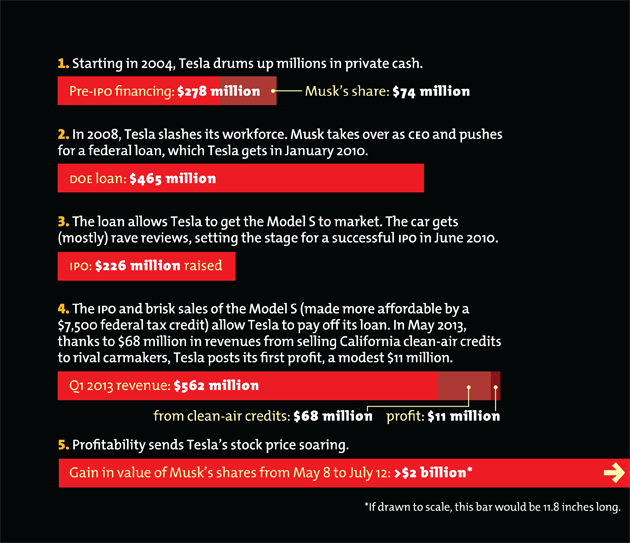
“Electric cars, solar panels, these are good things, and there are good reasons why the public should be supporting them,” Shellenberger continues. “We would all be better off if these entrepreneurs were a bit more grateful, a bit more humble. And I think that would help to tell a better story. We have this amazing engine of economic growth in Silicon Valley, and it depended heavily, if not entirely, upon 30 to 40 years of government support.”
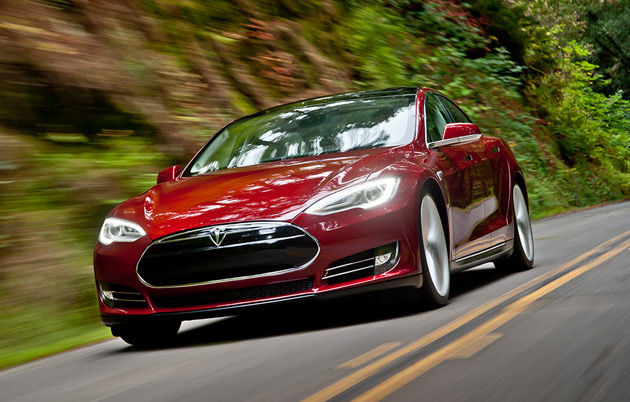
Inside Tesla’s sleek showroom in Menlo Park, a group of high schoolers drools over the Model S with a lust once reserved for the Ferrari Testarossa or Lamborghini Countach. “Whoa, awesome!” a pimply kid says as a brush of his hand causes the car’s recessed door handles to magically emerge. But the Model S’s biggest feat of engineering can’t be seen: “There’s over 7,000 of these stacked underneath,” Tina the sales rep tells me as she holds up what looks like a shotgun cartridge. It’s a Panasonic laptop cell.
No other component means as much to Tesla’s future. In order to make good on Musk’s pledge to roll out an affordable version of the $70,000 sedan within a few years, Tesla must shave thousands of dollars off its battery costs without seriously sacrificing range. That, however, may again depend on massive subsidies—in this case funding to battery researchers and manufacturers by the governments of Japan and China. Over the past five years, Japan’s New Energy and Industrial Technology Development Organization, a public-private partnership founded in 1980, has pumped roughly $400 million into developing advanced battery technologies. Tesla’s Panasonic cells also might be pricier if not for subsidies the company received to expand its battery plants in Kasai and Osaka. Government support means “faster and more efficient development” of next-gen batteries, Panasonic spokesman Chieko Gyobu says in an email. Without that backstop, many private companies are reluctant to gamble on groundbreaking technologies whose costs can easily spiral out of control.
Just look at Tesla. In 2007, it was teetering on the brink after its Roadster model ran way over budget and took twice as long as promised to get to market. Musk, then Tesla’s chairman, cut costs by pushing out many longtime employees—including cofounder and CEO Martin Eberhard. R&D director Peng Zhou anonymously leaked the company’s financials to Valleywag, revealing that Tesla had burned through “multiples of tens of millions” in customer deposits but had only delivered 50 cars. “I cannot consciously be a bystander anymore and allow my company to deceive the public and defraud our dear customers,” he told the tech blog a few days before submitting his resignation.
By this time, Musk had sunk $74 million of his own fortune into Tesla, and most of the rest into SolarCity and SpaceX. A divorce filing revealed that he’d borrowed from friends to cover his considerable living expenses. “Elon has huge steel balls. He truly does,” wrote his ex-wife, who said she learned of their impending divorce from a voice mail Musk left for her therapist. (Six weeks after filing for divorce, he was engaged to a British actress 15 years his junior.)
Musk was determined to keep Tesla alive. Making the Roadster profitable and selling battery packs to Daimler, he believed, would buy him enough time to secure government support to launch the Model S. “The application for this loan guarantee (and others) was instigated near the end of my tenure at Tesla, and was pushed very hard by Elon,” Eberhard told me via email. He doesn’t dispute his old partner’s claim that Tesla would have survived without the DOE loan, but writes, “it would have been difficult, and it would probably have required Tesla to raise more capital. This would likely have diluted Elon’s share of the company: Loans are nondilutive, whereas selling stock is dilutive. This is perhaps why Elon was so enthusiastic about pushing for the loans.”
So, in April 2009, Musk turned to one of his old business tactics: He threw a kegger. The politicos who gathered over beers in Washington’s National Building Museum were given rides in the Model S around a giant indoor track. Three months later, the loan was approved.
It was money well spent, especially compared with some of the DOE’s other investments: Fisker, a rival electric-car maker that received an even larger loan that year, has halted production and is now contemplating bankruptcy. By repaying his loan early, Musk distanced himself from such failures and helped reassure investors that Tesla could drive on its own. “I think the Tesla case is one that actually shows the value of these subsidies,” Motavalli told me. “And the Fisker case shows the danger of it.”
But make no mistake: Tesla still relies on subsidies to stay in the black. Its first-quarter profit, a modest $11 million, hinged on the $68 million it earned selling clean-air credits under a California program that requires automakers to either produce a given number of zero-emission vehicles or satisfy the mandate in some other way. For the second quarter, Tesla announced a $26 million profit (based on one method of accounting), but again the profit hinged on $51 million in ZEV credits; by year’s end, these credit sales could net Tesla a whopping $250 million. There are also generous tax credits and rebates for electric-car buyers: $7,500 from the federal government and up to $5,000 if you live in California.
SolarCity is even more dependent on subsidies. Its solar panels would cost a fortune if not for decades of government-funded R&D in the United States, Japan, and Germany—and huge manufacturing subsidies in China. Nor would SolarCity be profitable without a 30 percent federal tax credit for solar installations that allows it to sell electricity to consumers at rates below what the utilities charge. “We needed the incentives to get to the point where we are right now,” CEO Lyndon Rive told me. “It’s a fact.”
SpaceX might as well be part of NASA, which has coughed up more than $685 million to help the company develop its rockets and commercial space-flight capabilities—not to mention the hundreds of billions of dollars NASA and other public institutions have spent researching space travel over the decades.
Could Musk’s companies have taken flight without subsidies? Certainly many progressives would agree with his call for a carbon tax, but it’s no replacement for subsidies. The carbon tax that would be needed to prop up SolarCity, which installs run-of-the-mill residential panels, is well beyond what would be politically palatable. “Even with a carbon price, you are still going to need funding for next-generation R&D,” notes Cai Steger, an energy policy analyst with the Natural Resources Defense Council. “You are still going to need to address the fact that it’s incredibly difficult to get a really exciting, really risky product online.”
“I just think Elon hasn’t thought really deeply about what a carbon tax can and can’t do, and what it’s actually going to take to get technologies like his solar panels and electric cars competitive everywhere,” says Matthew Stepp, a senior policy analyst for the Information Technology and Innovation Foundation. “People in Europe, their gas is about $8 or $9 a gallon, and they are not driving electric cars, because there are a lot of inherent technological challenges with electric vehicles.” The point of a subsidy, Stepp adds, is to help companies create a clean car that people will actually buy.
The libertarians in Musk’s fan club seem willing to overlook his chummy relationship with Uncle Sam. At last year’s Atlas Summit, a conference for libertarian devotees of Ayn Rand, a panel on “SpaceX and the future of space flight” inspired breathless comparisons between Musk and John Galt, Rand’s persecuted inventor, who retires to a secret mountain hideaway dubbed Galt’s Gulch. Libertarians see outer space as a sort of Galt’s Gulch sans pareil—so long as getting there doesn’t mean ceding any control (or profit) to the federal government. “You can make the case that SpaceX is the ultimate in libertarian thought,” a former PayPal exec told me, “because although they are doing work with the government, they are also kind of taking away NASA’s monopoly.”
Of course, if SpaceX colonizes Mars on its own, it could very well become the government. Like the characters in the sci-fi novels he read as a child, Musk has a strong impulse to build his own city-state in the sky. He intends to lead the pilgrimage, and even has expressed his desire to die on the red planet—”just not on impact.”
He contents himself in the meantime with more modest excursions. In a nod to the past, he and Ressi have been competing to see who can throw the most outlandish birthday parties—trips for 30 friends and spouses to far-flung corners of the world, all expenses paid. “I am more into unusual destinations,” such as Florianópolis, an island off the coast of Brazil, Ressi says. “Elon favors castles.”
*Correction: The original version of this article, which ran in our September/October print issue, misnamed the book for which Motavalli interviewed Musk.



